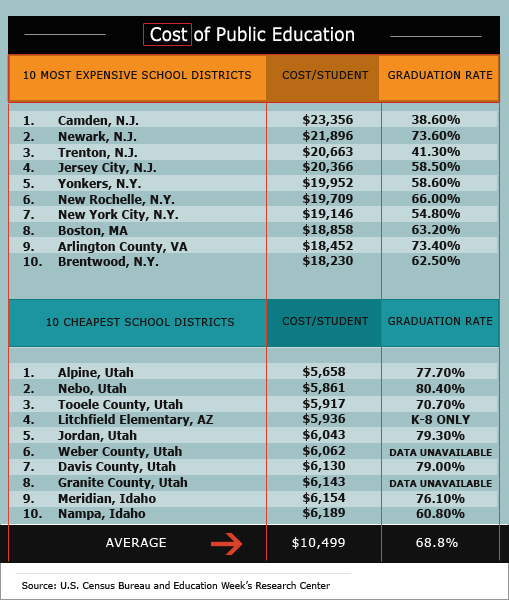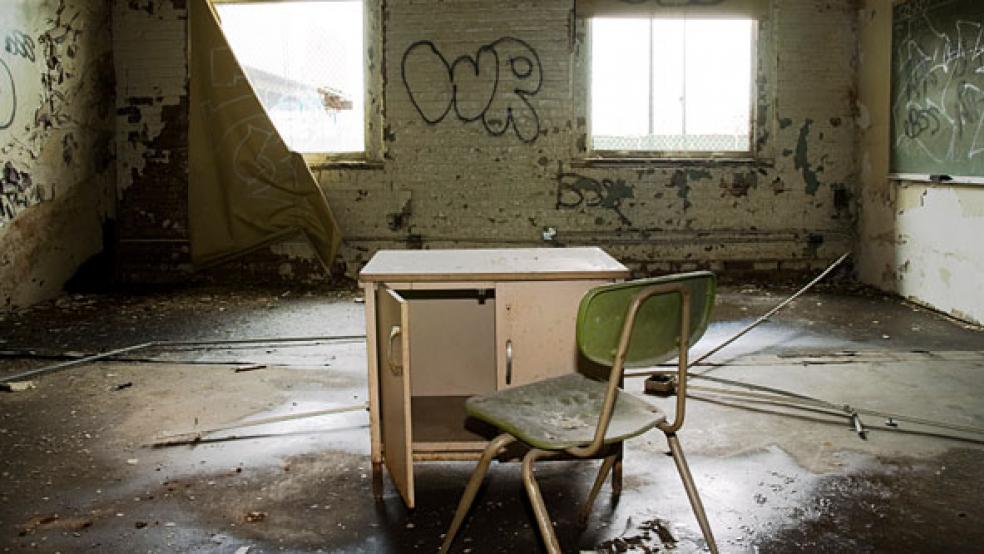Which public school district spends the most taxpayer money per student? One in Beverly Hills, perhaps? Or one in the swanky Park Avenue area of Manhattan?
Actually, it’s a district in Camden, N.J., according to new Census data on public school spending. Best known for urban blight and local corruption, Camden has an unemployment rate of 17 percent and 35 percent of its 80,000 inhabitants live below the poverty line. Fifty percent of residents are black, 15.5 percent white, 2.6 percent Asian; 10,000 people are crammed into each square mile. In 2008, the Federal Bureau of Investigation ranked it as the most dangerous city in America.
Camden High School, with an enrollment of 1,200 students, has less than a 40 percent graduation rate, and the former district chief of security Thomas Hewes-Eddinger has called it a “mini-jail.” Yet the district spends $23,356 per student, more than twice the national average.
Nearly 2,200 miles away lies the opposite example: the lowest-cost school district . Alpine school district is located in American Fork, Utah, a town of 27,000 people at the foot of Mount Timpanogos. The racial makeup is 95 percent white, 0.16 percent black and 0.65 percent Asian. The town’s median household income is $52,000; 4 percent of the population lives below the poverty line. The district spends a mere $5,658 per student, nearly half the national average, and has a 78 percent graduation rate.
Although they represent the extremes, these very different districts illustrate a troubling pattern that emerges in the school-spending data: The 10 most expensive schools have some of the lowest graduations rates, and the 10 schools that spend the least per student have some of the highest. Trenton, N.J., the third most expensive district ($20,663 per student), has a 41 percent graduation rate. New York City, number seven on the most expensive list ($19,146), is at 51 percent, 26 percent lower than the national average. While there are examples of school districts that spend relatively little and get a big bang for their bucks, including many districts in Massachusetts, the data, which was released last week, raises disturbing questions about how states spend education dollars. The data comes from the 2009 Census of Government Finances and covers public school spending during the 2008-2009 school year and revenue from federal, state and local sources in districts with enrollments of 10,000 or more.
“We’re not going to spend the same on students from disadvantaged backgrounds as students in the suburbs,” says Ulrich Boser, a senior fellow at the Center for American Progress who recently led a study called Return on Educational Investment, “but when you look across the U.S., we see that some schools are able to do more with less. In this time of sagging budgets, we should be engaged in thoughtful reform and make sure that we’re focusing on student achievement, and not spending more for policies that don’t show an actual impact on the ground.”

Many factors can contribute to high per pupil costs. The cost of living varies widely across the nation, as do teacher’s salaries. New York and California, two relatively expensive states , have the highest average teacher salaries at $69,118 and $68,093, respectively. The national average is $54,319, according to the National Education Association. Utah ($42,335) and North Dakota ($41,654) have the lowest salaries.
But teachers’ salaries don’t account for the entire difference. The Census data, which breaks down school spending by state as well as district, ranks California 30th based on pupil spending , well below average. Arkansas, meanwhile, which is a relatively inexpensive place to live, was fourth on the list with $15,552 a student, preceded by New York with the highest ($18,126), Washington, D.C., ($16,408) and New Jersey ($16,271). Utah spent the least per student ($6,356), preceded by Idaho ($7,092) and Arizona ($7,813).
Among the reasons for the high costs at low-performing schools are higher costs for security and more programs for underachieving students, which can be very expensive, according to Frank Johnson, an expert on school finances at the Department of Education. “If a kid is having reading problems, he immediately goes into a special reading program with three or five kids to a teacher, and that’s going to make the per-pupil expenditure for those kids much higher. And it just doesn’t work for all the kids. A lot of the kids drop out anyway,” he says. Camden spends 39 percent of its budget on teacher salaries, and 41 percent on support services, which include general administrative costs and security. It has a 124-officer security force. (Camden district officials didn’t return repeated phone calls and emails from The Fiscal Times.)
By comparison, Alpine spends 43 percent of its budget on teacher salaries, 26 percent on support services. Alpine School District spokesperson Rhonda Bromley says the district has received an award from the Association of Business Officials for 29 consecutive years for responsible fiscal management, and last year the district’s bond rating was upgraded, according to Bromley. Although they’ve felt the effects of the weak economy, she says no teachers have been laid off, and that they’ve cut back on administrator salaries. “We’ve been conservative in our spending,” she says.
Even though the growth of overall education spending slowed during the recession, with the largest cuts in Florida, Michigan and California, many high-cost school districts continue to ask states for funds to pour more money into the problem, hiring more staff and buying more equipment. Adding more money, however, does not appear to increase education quality or graduation rates.
In fact, additional spending corresponded to higher student achievement in only 16 states, according to the 2011 Return on Educational Investment study by the Center for American Progress. In five states, including Florida, Texas and New Jersey, more money meant slightly lower achievement. The study used a return-on-spending index for school districts developed by Standard & Poor’s, which looks at the percentage of students achieving reading and math proficiency for every $1,000 spent per student on core operations, to determine school productivity.
spending and the way student achievement
has largely remained stagnant, it’s hard not to
take away that there’s some sort of disconnect.”
Even after adjusting for cost of living and student poverty variables, they found that districts with lower productivity spent $950 more per student than districts with above average productivity, and the most inefficient districts tended to devote an extra 3 percent of their budgets to administration and other nonteaching expenditures. In addition, the census report found that employee benefits, such as pensions and health care, were the fastest-growing cost in education spending, increasing at twice the rate of salaries.
Recently, New Jersey’s Supreme Court mandated $500 million in additional funds to 31 urban school districts, leaving policymakers struggling to come up with the sufficient funds for the rest of the state’s public schools. The ruling dates back to a 30-year-old lawsuit which established that New Jersey’s high-poverty urban districts deserved extra funding. Some lawmakers are considering raising taxes to come up with the $500 million.
The Newark, N.J., school district famously received a $100 million donation last September from Facebook founder Mark Zuckerberg. Although the state took over the district in 1995 due to financial mismanagement and low achievement scores, Newark still ranks second on the list of most expensive districts, spending $21,896 per student, but its per-pupil spending has dropped slightly from $22,842 in 2007 while its graduation rate has been ticking up, suggesting that money may not be the driving force. Despite the advances, only 40 percent of students can read and write at grade level by the end of third grade. Zuckerberg says he chose Newark after meeting Newark Mayor Cory Booker and liking his reform proposals. So far, $1 million of it has been spent to survey parents’ thoughts on school reform; $99 million still sits in the bank. Many experts have questioned if more money is the answer to what they say is an already-bloated budget.
Obama has also made an effort to devote more spending to education, with $80 billion given to K-12 districts in the stimulus bill and his Race to the Top program offering states and addition $4.35 billion in federal funds if they can come up with innovative reform plans. In the 2012 budget estimate by the Office of Management and Budget, $43.2 billion is devoted to k-12 education, nearly a 50 percent increase since 2000.
“When you look at the large increases in spending and the way student achievement has largely remained stagnant,” says Boser, “it’s hard not to take away that there’s some sort of disconnect.”
Related Links:
The Ten States The Got Stiffed by Obama on Education Spending (Business Insider)
Smart Guy (Gates) Makes My List of ‘Dumbest Stuff I’ve Ever Read!’ (Huffington Post)
School Budget Cuts: A Small Town Fights Back (The Fiscal Times)




